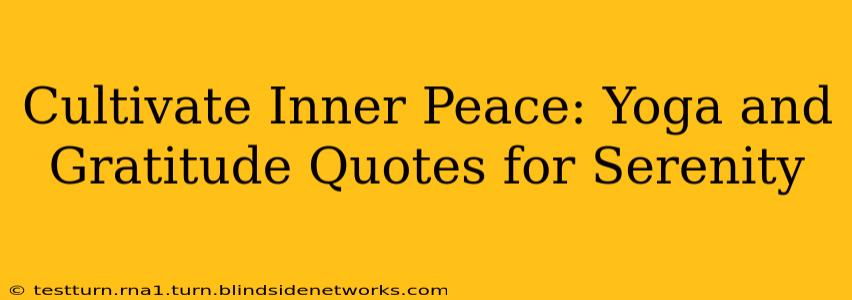In today's fast-paced world, finding inner peace can feel like searching for a hidden oasis in a bustling desert. The constant barrage of notifications, deadlines, and demands leaves many of us feeling stressed, anxious, and disconnected from ourselves. But what if I told you that a path to serenity exists, one paved with simple practices that can transform your inner landscape? This journey begins with cultivating inner peace, and I'm here to guide you on this transformative path using the powerful tools of yoga and gratitude.
What is Inner Peace?
Before we delve into the practical aspects, let's define our destination. Inner peace isn't the absence of challenges; it's the presence of calm amidst the storm. It's a state of mental and emotional tranquility, a feeling of contentment and acceptance, regardless of external circumstances. It's about finding harmony within yourself, a sense of balance that allows you to navigate life's ups and downs with grace and resilience.
Yoga: A Path to Physical and Mental Calm
Yoga, often perceived as just physical exercise, is so much more. It's a holistic practice that unites mind, body, and spirit. The physical postures (asanas) strengthen and stretch the body, releasing tension and promoting flexibility. But the true magic lies in the breathwork (pranayama) and meditation techniques integrated into yoga. Deep, conscious breathing calms the nervous system, reducing stress hormones and promoting a sense of groundedness. Meditation cultivates mindfulness, allowing you to observe your thoughts and emotions without judgment, creating space for inner peace to blossom.
How Does Yoga Cultivate Inner Peace?
- Stress Reduction: Yoga's physical postures and breathing techniques directly impact the body's stress response, lowering cortisol levels and promoting relaxation.
- Mindfulness: Yoga encourages present moment awareness, helping you detach from worries about the past or future.
- Body Awareness: Through yoga, you become more attuned to your body's signals, recognizing tension and releasing it before it escalates into stress or pain.
- Improved Sleep: Regular yoga practice can significantly improve sleep quality, contributing to overall well-being and reducing stress levels.
Gratitude: A Powerful Tool for Shifting Perspective
Gratitude acts as a powerful antidote to negativity. When we focus on what we're grateful for, our minds shift away from complaints and worries. This simple act of appreciation has a profound impact on our emotional state, fostering contentment and reducing stress. Keeping a gratitude journal, expressing thanks to others, or simply taking a moment each day to appreciate the small things can significantly enhance your sense of inner peace.
How Gratitude Fosters Inner Peace?
- Positive Emotions: Focusing on positive aspects of life triggers the release of endorphins, promoting feelings of happiness and well-being.
- Reduced Stress: Gratitude shifts your perspective from what's lacking to what you have, reducing feelings of anxiety and dissatisfaction.
- Improved Relationships: Expressing gratitude strengthens bonds with others, fostering connection and belonging.
- Increased Resilience: A grateful mindset helps you navigate challenges with more ease and resilience, viewing obstacles as opportunities for growth.
Yoga and Gratitude Quotes for Inspiration
Integrating inspiring quotes into your practice can further enhance your journey towards inner peace. Here are a few to consider:
- "Yoga is the journey of the self, through the self, to the self." - The Bhagavad Gita
- "The only way to do great work is to love what you do." - Steve Jobs (This applies to your yoga practice and your gratitude practice!)
- "Gratitude makes sense of our past, brings peace for today, and creates a vision for tomorrow." - Melody Beattie
Frequently Asked Questions (PAA)
What are some simple yoga poses for beginners to cultivate inner peace? Begin with simple poses like Child's Pose (Balasana), Mountain Pose (Tadasana), and Downward-Facing Dog (Adho Mukha Svanasana). These poses help to calm the nervous system and promote a sense of grounding.
How often should I practice yoga and gratitude to see results? Consistency is key. Aim for at least 20-30 minutes of yoga practice a few times a week, and incorporate gratitude into your daily routine, even if it's just for a few minutes.
Can yoga and gratitude help with anxiety and depression? While not a replacement for professional help, yoga and gratitude are powerful tools that can complement therapy and medication in managing anxiety and depression. They promote relaxation, reduce stress, and foster a more positive outlook.
Are there any resources to help me learn more about yoga and gratitude? Numerous online resources, books, and apps can guide you. Look for reputable yoga instructors and explore books and websites focusing on mindfulness and gratitude practices.
Conclusion: Embrace the Journey
Cultivating inner peace is a journey, not a destination. It requires consistent effort and self-compassion. By embracing the practices of yoga and gratitude, you'll not only find moments of serenity but also cultivate a lasting sense of calm and contentment that enriches every aspect of your life. So, take a deep breath, find a quiet space, and begin your journey towards inner peace today. Remember, the most important step is the first one.

